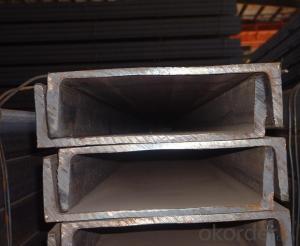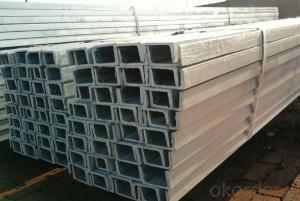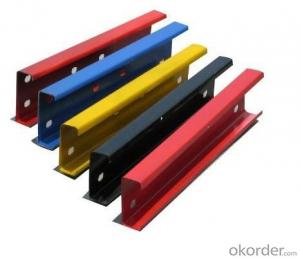Hot Rolled U CHANEEL 5-300mm or High Quality GB OR JIS
- Loading Port:
- China Main Port
- Payment Terms:
- TT or LC
- Min Order Qty:
- -
- Supply Capability:
- -
OKorder Service Pledge
OKorder Financial Service
You Might Also Like
Product Description:
OKorder is offering high quality Hot Rolled Steel I-Beams at great prices with worldwide shipping. Our supplier is a world-class manufacturer of steel, with our products utilized the world over. OKorder annually supplies products to European, North American and Asian markets. We provide quotations within 24 hours of receiving an inquiry and guarantee competitive prices.
Product Applications:
1.The JIS U Channel Steel can be devided into two kinds, namely common channel steel and light channel steel. The sizes of hot rolled common channel steel range from 5# to 40#. Meanwhile, the channel steel can be divided into cold forming sectional equal channel steel, cold forming sectional unequal channel steel, cold forming inner edge channel steel and outer edge channel steel.
2.The JIS u channel steel is usually used for arch-itechtural structure, and they could be welded in order to support or hang a vari-ety of facilities. They are also usually used in combination with I beam. The channel steel with sizes under 14# is usually applied to construction engineering, as purline, while the channel steel with sizes above 16# is more likely to be used in building vehicle chassis structure and mechanical structure. Furthermore, the channel steel in sizes above 30# are target at building bridge structure, as tension bar.
3.In a word, the channel steel must possess perfect welding property, riveting property and mechanical property and so on.
Product Advantages:
OKorder's Steel I-Beams are durable, strong, and resist corrosion.
Main Product Features:
· Premium quality
· Prompt delivery & seaworthy packing (30 days after receiving deposit)
· Corrosion resistance
· Can be recycled and reused
· Mill test certification
· Professional Service
· Competitive pricing
Product Specifications:
Manufacture: Hot rolled
Grade: Q195 – 235
Certificates: ISO, SGS, BV, CIQ
Length: 6m – 12m, as per customer request
Packaging: Export packing, nude packing, bundled
Original Place | Tangshan, China | Brand Name | UINDA |
Standard | JIS G3192 : 1990 | ||
Material Grade | SS490 | ||
Sizes | 50mm to 200mm | ||
Sales Volume/Year | 3000MT | ||
Destination Area | Middle East, Africa, Southeast Asia | ||
2. The sections in details are as followings in the table-1
JIS U CHANNEL | Standard | Sectional | Dimension |
| Mass: |
| (mm) | (mm) | (mm) | (mm) |
|
50x25 | 50 | 25 | 3.0 | 6.00 | 2.37 |
75X40 | 75 | 40 | 3.8 | 7.00 | 5.30 |
75X40 | 75 | 40 | 4.0 | 7.00 | 5.60 |
75X40 | 75 | 40 | 4.5 | 7.00 | 5.85 |
75X40 | 75 | 40 | 5.0 | 7.00 | 6.92 |
|
|
|
|
|
|
100X50 | 100 | 50 | 3.8 | 6.00 | 7.30 |
100X50 | 100 | 50 | 4.2 | 6.00 | 8.03 |
100X50 | 100 | 50 | 4.5 | 7.50 | 8.97 |
100X50 | 100 | 50 | 5.0 | 7.50 | 9.36 |
|
|
|
|
|
|
125X65 | 125 | 65 | 5.2 | 6.80 | 11.66 |
125X65 | 125 | 65 | 5.3 | 6.80 | 12.17 |
125X65 | 125 | 65 | 5.5 | 8.00 | 12.91 |
125X65 | 125 | 65 | 6.0 | 8.00 | 13.40 |
|
|
|
|
|
|
150x75 | 150 | 75 | 5.5 | 7.30 | 14.66 |
150x75 | 150 | 75 | 5.7 | 10.00 | 16.71 |
150x75 | 150 | 75 | 6.0 | 10.00 | 17.90 |
150x75 | 150 | 75 | 6.5 | 10.00 | 18.60 |
150x75 | 150 | 75 | 6.5 | 10.00 | 24.00 |
|
|
|
|
|
|
200X80 | 200 | 80 | 7.5 | 11.00 | 24.60 |
3. The mechanical property of JIS U Channel Steel in the table-2:
Grade | Yield Strength,N/mm² | Extension Strength N/mm² | |||
Thickness of Steel,mm | |||||
≦16 | >16-≦40 | >40-≦100 | >100 | ||
SS490 | ≧285 | ≧275 | ≧255 | ≧245 | 490-610 |
4. The chemical composition of JIS U Channel Steel as per SS490 in the table-3
Grade | Element(%) | |||
C | Mn | P | S | |
SS490 | - | - | ≦0.050 | ≦0.050 |
FAQ:
Q1 Can stainless steel rust?
A1 Stainless does not "rust" as you think of regular steel rusting with a red oxide on the surface that flakes off. If you see red rust it is probably due to some iron particles that have contaminated the surface of the stainless steel and it is these iron particles that are rusting. Look at the source of the rusting and see if you can remove it from the surface.
Q2: How do you package the angle steel when shipping?
A2: All goods are packed in bundles with steel strips and shipped by container or break bulk.
Q3: The products are invoicing on theoritical weight or on actual weight?
A3: We can do it in both manners, according to the customers' request.


- Q: What are the common material testing procedures for steel channels?
- Common material testing procedures for steel channels include tensile testing, hardness testing, impact testing, and dimensional inspection. Tensile testing involves pulling a sample of the steel channel until it breaks to determine its strength and ductility. Hardness testing measures the resistance of the steel to indentation or scratching, providing an indication of its overall toughness. Impact testing assesses the steel's ability to withstand sudden, high-force impacts. Dimensional inspection ensures that the steel channels meet the required size and shape specifications.
- Q: Channel 10 is calculated, if the price per metre is calculated
- No. 10 channel steel is calculated, that is to say, the standard weight, that is, all channel sizes have reached the standard, our national standard No. 10 channel steel theoretical weight is 10.007 kg / meter.
- Q: Can steel channels be used in the telecommunications parts manufacturing industry?
- Yes, steel channels can be used in the telecommunications parts manufacturing industry. Steel channels are commonly used in various industries due to their strength, durability, and versatility. In the telecommunications industry, steel channels can be used to support and protect cables, provide structural support in equipment racks, or as mounting brackets for various components. They offer excellent load-bearing capabilities and can withstand harsh environmental conditions, making them suitable for telecommunications parts manufacturing.
- Q: What are the different methods of bending steel channels?
- There are several methods of bending steel channels, including cold bending, hot bending, and press bending. Cold bending involves using a bending machine to gradually bend the steel channel to the desired angle. Hot bending is achieved by heating the channel to a high temperature and then using a bending machine or hydraulic press to shape it. Press bending involves using a hydraulic press to exert force on the channel and gradually bend it to the desired angle. Each method has its own advantages and suitability depending on the specific requirements of the project.
- Q: What are the factors that affect the cost of steel channels?
- The cost of steel channels can be affected by several factors. Firstly, the cost of raw materials plays a significant role. Factors like supply and demand, production costs, and global economic conditions can directly impact the price of steel, thus affecting the cost of steel channels. Another factor that influences the cost is the size and specifications of the channels. Larger or more specialized channels may require additional processing or customization, leading to increased costs. The complexity of the design or the need for specific coatings or finishes can also impact the final price. The manufacturing process itself contributes to determining the cost. Different production methods, such as hot-rolling or cold-forming, have varying associated costs. Additionally, the location of the steel production facility and transportation costs can affect the overall price. Market conditions and competition also have a role in determining the cost of steel channels. When demand is high and supply is limited, prices tend to rise. Conversely, during periods of low demand or increased competition, prices may decrease. Lastly, any additional services or value-added features, like cutting, drilling, or welding, can increase the cost of steel channels. These services require additional labor, equipment, and expertise, resulting in an overall higher price. In conclusion, the cost of steel channels is influenced by various factors, including raw material prices, size and specifications, manufacturing process, market conditions, competition, and additional services. It is crucial for businesses and consumers to understand these factors in order to make informed decisions when purchasing steel channels.
- Q: What are the different methods of installation for steel channels?
- There are several methods of installation for steel channels, including welding, bolting, and adhesive bonding. Welding involves joining the channels using a high-temperature process that creates a strong and permanent connection. Bolting involves using bolts and nuts to secure the channels together, allowing for easier disassembly if needed. Adhesive bonding utilizes strong adhesives to bond the channels, providing a reliable and versatile installation method. The choice of installation method depends on factors such as the application, load requirements, and ease of installation.
- Q: What are the advantages of using steel channels over other materials?
- One advantage of using steel channels over other materials is their strength and durability. Steel channels have a high tensile strength, allowing them to withstand heavy loads and resist bending or warping. Additionally, steel is highly resistant to corrosion, making it suitable for outdoor applications or in environments with high moisture levels. Another advantage is the versatility of steel channels, as they can be easily fabricated and shaped to meet specific design requirements. Furthermore, steel is a sustainable material that can be recycled, reducing the environmental impact.
- Q: Can steel channels be used for structural support?
- Indeed, structural support can be achieved by utilizing steel channels. In the realm of construction, steel channels are frequently employed due to their ability to offer robustness and longevity. Buildings, bridges, and other structures often utilize steel channels to ensure stability and support. These channels are engineered to distribute weight and load evenly, making them an optimal choice for structural support. Moreover, their versatility enables them to be tailored to meet specific design criteria with ease. Ultimately, steel channels are a dependable and efficient option for providing structural support in diverse construction endeavors.
- Q: How are steel channels classified based on their shape?
- Steel channels are classified based on their shape into three main categories: C channels, U channels, and miscellaneous channels. C channels, also known as C-shaped channels or simply channels, have a distinct shape resembling the letter "C". They have a flat vertical back and two horizontal flanges extending outward from the back. C channels are widely used in construction and structural applications, providing excellent load-bearing support. U channels, also referred to as U-shaped channels or simply U-channels, have a U-shaped cross-section with two vertical sides and a horizontal base. The two vertical sides are known as flanges, while the horizontal base is called the web. U channels are commonly employed in manufacturing and fabrication processes, offering stability and strength to various structures. Miscellaneous channels encompass all other steel channel shapes that do not fit into the C or U channel categories. These channels can have a range of shapes and sizes, including tapered flanges, uneven sides, or unique profiles. Miscellaneous channels are utilized in specialized applications where specific design requirements need to be met. In summary, steel channels are classified based on their shape into C channels, U channels, and miscellaneous channels, each serving different purposes in construction, manufacturing, and other industries.
- Q: Can steel channels be used for balcony railings?
- Balcony railings can indeed utilize steel channels. With their strength and durability, these channels offer ideal support and safety features for balconies. Their dimensions and design can be easily customized to meet specific requirements. Moreover, steel channels have excellent resistance to corrosion and can endure harsh weather conditions, proving their reliability for outdoor usage. Whether for residential or commercial purposes, steel channels present a versatile and visually appealing choice for balcony railings.
Send your message to us
Hot Rolled U CHANEEL 5-300mm or High Quality GB OR JIS
- Loading Port:
- China Main Port
- Payment Terms:
- TT or LC
- Min Order Qty:
- -
- Supply Capability:
- -
OKorder Service Pledge
OKorder Financial Service
Similar products
Hot products
Hot Searches
Related keywords




























